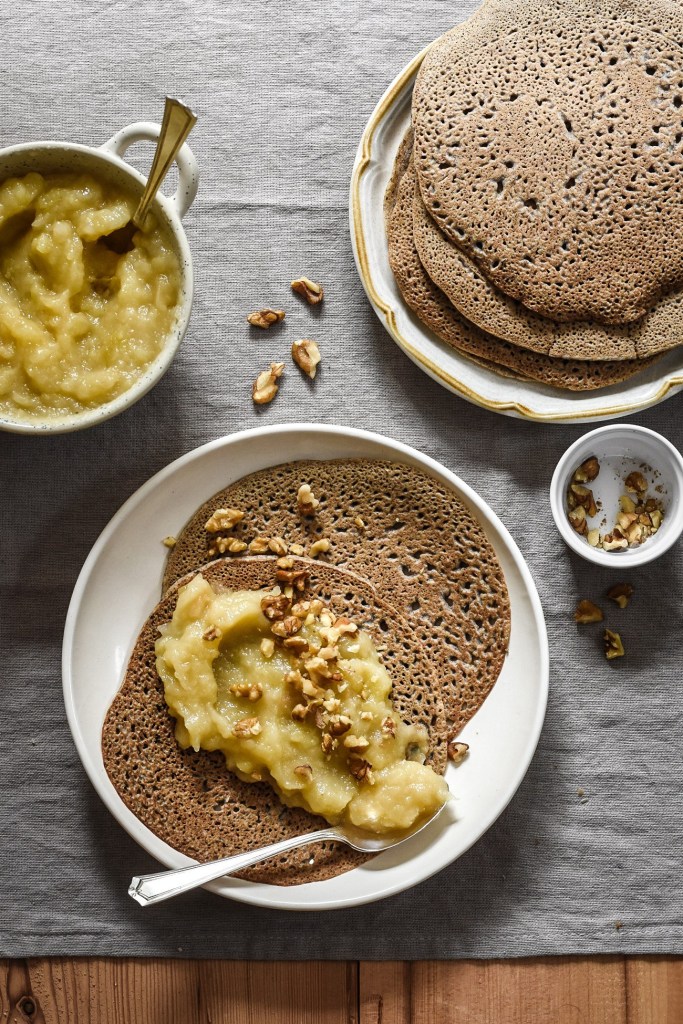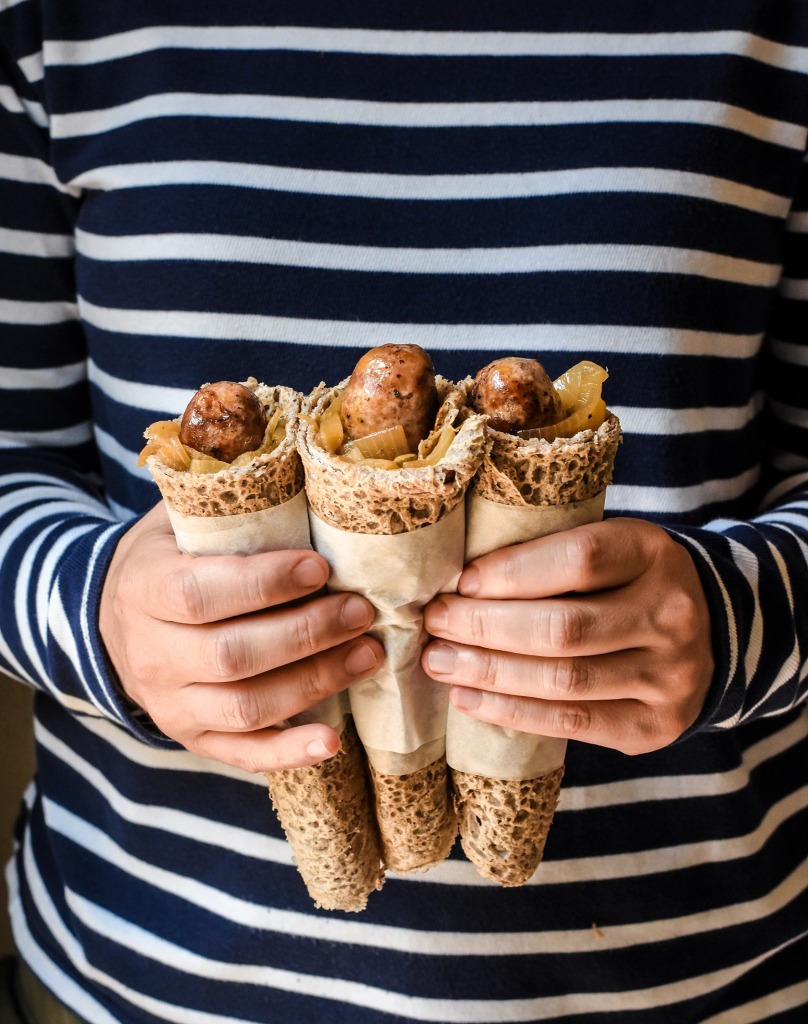Audrey Le Goff is a French food writer at Pardon Your French and the author of Rustic French Cooking Made Easy. Audrey talks buckwheat crepes, the proper French greeting and Brittany’s rainy weather.
Photo: Pardon Your French
What do you feel defines the cuisine in Brittany?
To understand Brittany cuisine, you have to understand its land. Brittany is a peninsula extending into the Atlantic Ocean. On one side, L’Armor (the sea) provides an abundance of fish, seafood and shellfish, which are all prominent on Brittany’s tables. On the other side, L’Argoat (the inland) has rich soil fields and a mild climate prone to growing sturdy produce like artichoke and cauliflower, root vegetables, apples and a wealth of buckwheat – a star ingredient of Brittany cuisine.
With a strong farming heritage, Brittany is also known for its excellent meat and dairy production: milk, cream and amazing butter which gives way to lots of very buttery baked goods. Compared to the idea of what most people have of French cuisine, Brittany cuisine is far more rustic, humble and often focuses on the taste rather than the look. Simple techniques, uncomplex dishes, no fancy pastries… It’s all about celebrating the sea and the land, honouring the local ingredients and keeping things laid-back.
What is the one local dish you feel travellers can’t leave Brittany without trying?
Crêpes, of course. But make sure to go for the authentic savoury buckwheat crêpes. Those made with wheat flour are only meant to be enjoyed with sweet fillings, for dessert. When dining at a crêperie, order a crêpe complete. The most classic buckwheat crêpe filled with ham, cheese and egg. For the whole Breton experience, eat it alongside a glass of cider, plus a mug of lait ribot (the local buttermilk).
That said, you can’t leave Brittany either without trying a kouign-amann or a gâteau breton.
Photo: Pardon Your French
What about your favourite restaurants?
I am partial to my hometown Lorient which has a good dining screne, including great restaurants like Le Tire Bouchon, L’Alsace à Quai, Le 26-28 and Le Jardin Gourmand. Although sadly, my absolute favourite local crêperie La Rose Des Sables did not survive the Covid-19 lockdown and permanently closed just last week. Local chef Jérôme Le Teuff makes great chocolates and pastries. When living in Rennes during my university years, my favourites spots were Crêperie St Georges and the crêperie La Rozell. But do know that just as important as the restaurants are, markets are equally as important in Brittany. The Lices Market in Rennes on Saturdays, is one of France’s most bountiful markets. Here you will find the best galettes saucisses – an iconic street food in Brittany – which are buckwheat crêpes wrapped around pork sausages.
Photo: Pardon Your French
Name one best kept secret of Brittany
I think my hometown Lorient is one of Brittany’s newest best kept secrets. Up until a few years ago, Lorient didn’t have a great reputation and never struck as a must-see site. The town was almost entirely bombed during WWII and re-built in the 50s and 60s with quite plain, unappealing architecture. Forget cobbled streets and medieval charm. But recently, Lorient has experienced a wonderful revival, with plenty of tasteful renovations, new restaurants, and a major new sailing hub attracting sailors from worldwide. It is today an attractive sea-side town with marinas, beautiful surfing beaches and lots of bars and cafes. And because this revival is quite recent, Lorient still isn’t as touristy as other sea-side towns, which makes it even more enjoyable for a relaxing stay in Brittany.
Name one French etiquette most travellers miss
Well, of course this rule doesn’t apply anymore in the Covid-19 era, but in France, kissing on the cheek is the proper way to greet someone, even between two male or female friends. Don’t try to hug or you’ll likely get pushed back in bewilderment. Hugs are perceived as a quite intrusive gesture, and you will never see people hugging to say hi, except lovers. To make things even trickier, you’ll need to judge how many kisses should you bestow, as the number can vary from one French region to the other. Four kisses in the South, three in the North and in Brittany, it’s two.
What’s the perfect itinerary to explore Brittany?
Brittany is a large region with incredibly varied landscape, so try to see a bit of it all. Start with Rennes, the capital and biggest city of Brittany, which has an exciting cultural scene and a lively medievel old quarter with lots of typical taverns. After that, venture in-land to experience a more bucolic Brittany living. There a plenty of small medieval cities in-land such as Dinan, La Gacilly, Locronan, or Pont-Aven that’ll make you feel like you stepped back in time. The city of Quimper is also a must-see, with cobbled streets and superb slanted half-timbered houses – traditional Breton architecture. Lastly, and most absolutely, head to the coastline. I would recommend a stay in Carnac on the Southern coast, home to beautiful beaches and an impressive Megalithic site; or a stay in the walled city of St-Malo on the Northern coast, filled with history and pirate legends.
What is one travel tip you would give to travellers heading to Brittany?
Definitely pack a rain jacket. Brittany is known for its changing weather and iconic crachin breton (Breton drizzle). The cliché of Breton people wearing thick blue stripes sweaters and yellow rain coats exists for a reason. Even in the Summer, you can get rain and wind on a daily basis. But don’t let the weather stop you! I actually think a hike on a craggy coastal path is far more typically Breton when done under a drizzle and gusts of wind.
Where is the perfect weekend getaway in Brittany?
Brittany’s coast has islands aplenty, and they all make for the perfect weekend getaway. Belle Île, Brittany’s biggest island, Ouessant or Île-de-Bréhat are popular islands with stunning beaches and untouched nature. But my personal favourite is perhaps l’Ile de Groix, off the coast of Lorient. It is a tiny huddle of slow-living, accessible by a 45 minutes ferry ride from Lorient. It offers tall cliffs on the north side of the island and a famous beach of turquoise water on the east side, called Les Grands Sables, that’ll make you feel like you are in the Caribbean. You can eat amazing mussels and frites at Port Tudy, the island’s main town, while watching the fishing boats entering and exiting the harbour. If you’re like me, you’ll never want to leave.
WHERE TO EAT IN BRITTANY
Le Tire Bouchon
Where: 45 Rue Jules le Grand, 56100 Lorient, France
For: Traditional French cuisine
L’Alsace à Quai
Where: 19 cours de la Bove, 56100 Lorient France
For: Fish and chips
Le 26-28
Where: 26 Rue Poissonnière, 56100 Lorient, France
For: Contemporary seasonal cuisine
Le Jardin Gourmand
Where: 46 rue Jules Simon, 56100 Lorient France
For: Well-dressed dinners
Pâtisserie Jérôme Le Teuff
Where: 4 Rue Joseph Rollo, 56100 Lorient, France
For: Chocolates and pastries
Crêperie St Georges
Where: 11 Rue du Chapitre 35000 Rennes, France
For: Crêpes
La Rozell
Where: 14 Rue de Penhoët, 35000 Rennes, France
For: Crêpes
Lices Market
Where: 3 Place du Bas des Lices, 35000 Rennes, France
For: Galettes saucisses
WHERE TO GO IN BRITTANY




